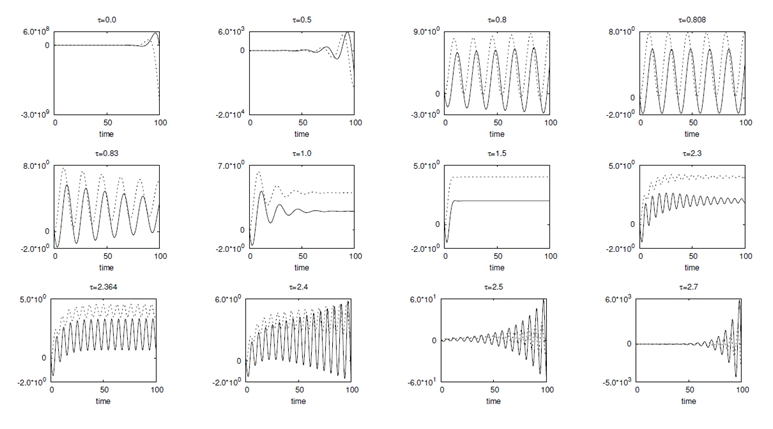The dynamics of love can look like a sine wave, with smooth, repetitive highs and lows. That's probably not too bad. We certainly try for a flat line but that is difficult to achieve. What you want to avoid is having your other half begin to vibrate weirdly. When that happens, couples oscillate without any harmony, the waves go out of control and soon you are forced to get back down to dating weight.
Steven Strogatz first described romance with a dynamical system in 1988. He constructed a 2-D model describing two hypothetical partners that interact emotionally. The well known example he used was Romeo and Juliet during their short, tumultuous affair. As everyone knows, a bunch of murders and suicides in a few days time are not indicative of a harmonious teenage relationship. It was not an elegant sinusoid.
But, note Natalia Bielczyk and colleagues from Radboud University Nijmegen, a Strogatz model doesn't include delays in the partner responses to each other, so they added reactivity parameters: Personal history of the couple, their ‘past’, and reactivity to their partner and his/her history. With those parameters, more complex relationships can be modeled. Some are predictably doomed to fail while others are always stable. Stability occurs when both partners reach a stable level of satisfaction and the sine wave narrows or even disappears.
They even say that delays in reactivity can bring stability to couples that are originally unstable. Relationship counseling using the function sine. That's practical math.

Romeo and Juliet's vaguely weird relationship - the math. Romeo is in solid lines and Juliet is dashed. The tau (τ) above the individual figures indicates the delay in reactivity. As this shows, delays that are too short (<0.83) cause instability but so do delays that are too long (>2.364). Delays in the range of 0.83 - 2.364 cause stability for the young lovers but outside that and a whole bunch of people die. And you thought your teenage years were dramatic. Credit: Radboud University Nijmegen
The results are pretty intuitive though nothing you didn't already know - responses that are too delayed, or even too prompt, are a sign (get it??) of trouble. Under a certain threshold, delays mean instability and above it is stability. Hey, it isn't perfect. It takes a modern robot 25 minutes to fold a towel but based on that Ray Kurzweil says we will ascend into robot overlords by 2045 so I can believe we will model romance numerically long before that.
Why is numerical modeling going to be better for men? Because a range is optimal, and anything too fast causes instability, the math can tell you how lazy you can be in a relationship yet still claim you are working on maintaining a healthy response rate. Covertly. You are doing it for her.
But don't get cocky. You can't just mimic her moods and think your super-fast emotional reactivity to her ups and downs will allow you to watch the big game on Sunday without a conversation about 'us' and 'the relationship'. Suspiciously fast reactivity also leads to destabilization because you won't have allowed enough time for those compound emotions to form. She'll see right through it, without ever touching a calculator.
Social psychology is awesome. Talking, monitoring emotional levels and picking the right moment can take the place of trying to change the other person, which hasn't actually worked in a million years.
Citation: Natalia Bielczyk, Marek Bodnar, Urszula Foryś, 'Delay can stabilize: Love affairs dynamics', Applied Mathematics and Computation http://dx.doi.org/10.1016/j.amc.2012.10.028




Comments